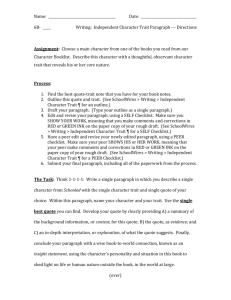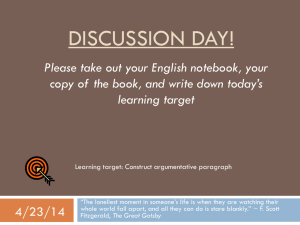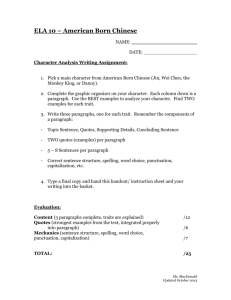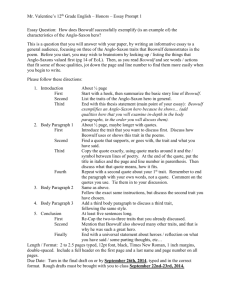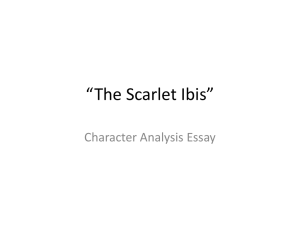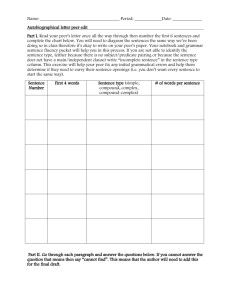Name: Date: 6B- _____ Reading: Biography Character Trait
advertisement
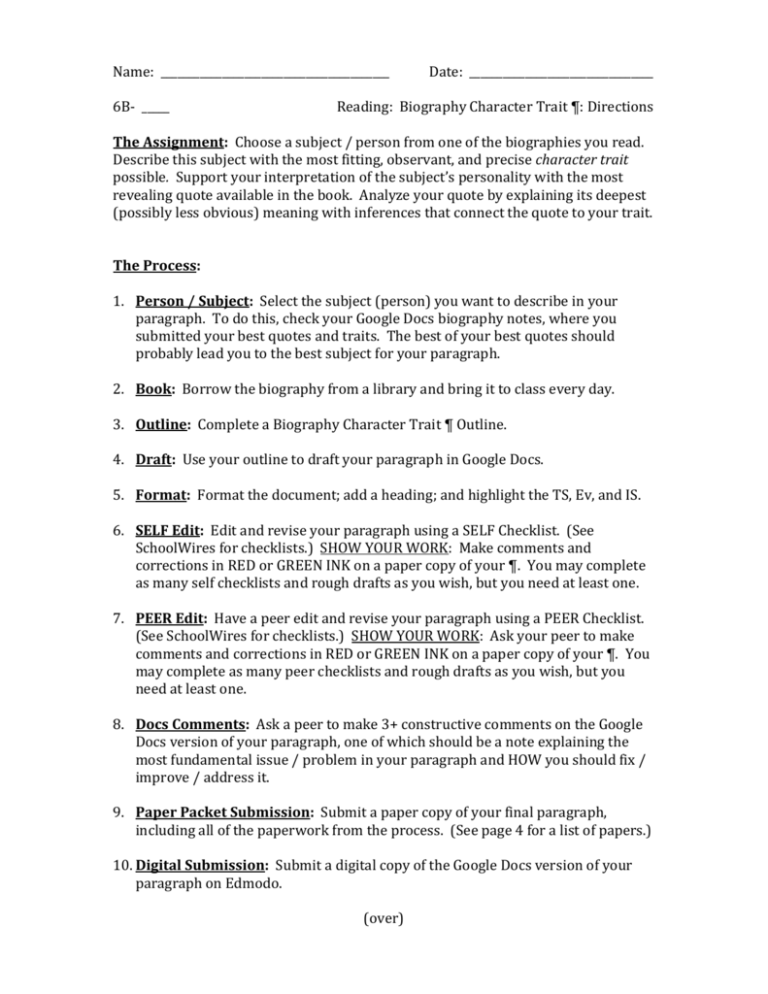
Name: _________________________________________ 6B- _____ Date: _________________________________ Reading: Biography Character Trait ¶: Directions The Assignment: Choose a subject / person from one of the biographies you read. Describe this subject with the most fitting, observant, and precise character trait possible. Support your interpretation of the subject’s personality with the most revealing quote available in the book. Analyze your quote by explaining its deepest (possibly less obvious) meaning with inferences that connect the quote to your trait. The Process: 1. Person / Subject: Select the subject (person) you want to describe in your paragraph. To do this, check your Google Docs biography notes, where you submitted your best quotes and traits. The best of your best quotes should probably lead you to the best subject for your paragraph. 2. Book: Borrow the biography from a library and bring it to class every day. 3. Outline: Complete a Biography Character Trait ¶ Outline. 4. Draft: Use your outline to draft your paragraph in Google Docs. 5. Format: Format the document; add a heading; and highlight the TS, Ev, and IS. 6. SELF Edit: Edit and revise your paragraph using a SELF Checklist. (See SchoolWires for checklists.) SHOW YOUR WORK: Make comments and corrections in RED or GREEN INK on a paper copy of your ¶. You may complete as many self checklists and rough drafts as you wish, but you need at least one. 7. PEER Edit: Have a peer edit and revise your paragraph using a PEER Checklist. (See SchoolWires for checklists.) SHOW YOUR WORK: Ask your peer to make comments and corrections in RED or GREEN INK on a paper copy of your ¶. You may complete as many peer checklists and rough drafts as you wish, but you need at least one. 8. Docs Comments: Ask a peer to make 3+ constructive comments on the Google Docs version of your paragraph, one of which should be a note explaining the most fundamental issue / problem in your paragraph and HOW you should fix / improve / address it. 9. Paper Packet Submission: Submit a paper copy of your final paragraph, including all of the paperwork from the process. (See page 4 for a list of papers.) 10. Digital Submission: Submit a digital copy of the Google Docs version of your paragraph on Edmodo. (over) The Task: Think 1-1-1-1-1: Write one paragraph in which you describe one subject from a one biography with the one character trait that best describes your character’s personality and the one quote that most convincingly supports your trait. Develop your quote by clearly providing A) a summary of the background information, or context, for this quote; B) the quote, as evidence for your trait; and C) an in-depth interpretation, or explanation, of HOW the quote supports the trait. Finally, conclude your paragraph with a wise book-to-world connection, known as an insight statement, using the subject’s personality and situation in this book to shed light on life or human nature outside the book, in the world at large. Tone: Write your argument for an audience, or readers, who might be unfamiliar with your book. Use a factual, formal, impersonal or objective tone. In other words, avoid referring to yourself (I, me, my, mine…); your reader (you, your, yours…); or your writing (in this paragraph…; this quote proves that…; in conclusion…; etc.). Avoid slang (casual language: stuff; OK; Well, Cap thinks…; etc.). Character Traits: A character trait is a distinguishing descriptive word (an adjective) that describes an important part of a subject’s personality. To single out a character trait for aperson, think about what this person says (Dialogue); what he or she does (Actions); what he or she feels (Feelings); and what he or she thinks (Thoughts). Likewise, you might want to think about other people’s Dialogue, Actions, Feelings, and Thoughts regarding your subject. Think D.A.F.T.: Dialogue, Actions, Feelings, and Thoughts. Basic information and physical looks can also shape a person’s character, though they tend not to be the most revealing details. Often the most dramatic or meaningful moments in the book will provide you with your evidence. During these moments, people define themselves. You should avoid traits that are too general, too simple, or too superficial (nice, funny, cool, mean, special, amazing, etc.). Lastly, avoid judgmental language (weird, stupid, dumb, abnormal, clueless, cocky, etc.) and slang (beast, boss, cool, “it,” etc.), as well as traits for a temporary mood (shocked, disappointed, etc.). Quotes: The best quotes are deeply revealing; they give readers access into a character’s values, thoughts, feelings, philosophy, etc. They tend to sound poetic, and they are written / said in such a way that you wouldn’t want to re-write them in your own words. Changing the language of the quote would lessen its power or meaning. Remember: You may quote dialogue (talking) or narration (story-telling). (next) 2 Examples of Character Traits: Self-Assured, Confident Insecure, Timid, Fearful, Awkward Selfless, Humble, Modest, Unassuming, Self-Centered, Narcissistic, Conceited, Respectful, Attentive Arrogant, Superficial, Materialistic, SelfAbsorbed, Self-Righteous Loyal, Altruistic, Faithful Disloyal, Opportunistic Mature, Responsible, Trustworthy Immature, Irresponsible, Untrustworthy Wholesome, Philanthropic, Humane, Malicious, Malevolent, Mischievous, Compassionate, Empathetic, Pacifistic, Inhumane, Insidious, Conniving, Even-Tempered, Easy-Going, Argumentative, Quarrelsome, Benevolent, Noble, Virtuous, Dignified Aggressive, Restless, Irritable, Cantankerous, Ill-Tempered Honest, Sincere, Candid, Outspoken Dishonest, Insincere, Deceitful, Conniving Observant, Perceptive, Wise, Insightful Apathetic, Gullible, Passive, Vulnerable, Foolish, Naïve, Ignorant Open-Minded, Adaptable, Reflective, Close-Minded, Stubborn, Judgmental, Fair, Impartial, Unbiased, Critical, Cynical, Biased, Prejudiced, Rational, Even-Handed, Conscientious, Intolerant, Bigoted, Discriminatory, Righteous, Well-Intentioned, Tolerant, Narrow-Minded, Opinionated, Unjust Lenient Courageous, Bold, Audacious, Brave, Fearful, Regretful, Cowardly, Meek, Assertive, Uninhibited, Expressive Timid, Shy, Retiring, Reserved, Withdrawn, Solitary, Inhibited, Shameful Moral, Ethical, Scrupulous, Honorable, Immoral, Unethical, Unprincipled, Reputable, Genuine, Unpretentious Unscrupulous, Dishonorable, Corrupt, Fraudulent, Deceitful, Duplicitous, Hypocritical Optimistic, Hopeful, Idealist Pessimistic, Negative Powerful, Domineering Powerless, Submissive Charismatic, Charming, Polite Despicable, Loathsome, Rude, Smug Generous, Charitable Miserly, Spiteful, Unmerciful Patient Impatient Introverted, Extroverted Anti-Social, Deviant Superior, Ambitious, Power-Hungry, Inferior, Self-Conscious Competitive Determined, Persistent, Tenacious, Indecisive, Hesitant, Self-Doubting, Resolute, Steadfast, Insistent, Decisive, Faltering, Fickle, Ambivalent, Committed, Dedicated, Diligent, Non-Committal, Industrious, Meticulous, Thorough Grateful, Appreciative, Gracious Ungrateful, Unappreciative Independent, Self-Sufficient, Resourceful, Dependent, Needy, Unimaginative, Dull, Imaginative, Creative, Practical, Insipid, Sheltered Inventive, Original, Quirky, Idiosyncratic Note: A character trait is NOT a physical description: tall, short, messy, neat, etc.; a mood (bored, “hyper”); a temporary reaction (stunned, surprised, shocked, confused); a noun: leader, follower, hippy, bully, athlete, jock, etc. (over) 3 Final Paper Packet: [Submit in this order, from top to bottom.] 1. Final copy 2. PEER checklist(s) on top of PEER rough draft(s), from newest to oldest. *Put checklist(s) ON TOP OF its rough draft(s). *You only need ONE PEER checklist and ONE PEER rough draft. 3. SELF checklist(s) on top of SELF rough draft(s), from newest to oldest. *Put checklist(s) ON TOP OF its rough draft(s). *You only need ONE SELF checklist and ONE SELF rough draft. 4. Outline * Don’t staple your packet. * Keep these papers in a sheet protector until the due date, when you’ll submit them. DUE DATE: ____________________________________________________ 4
